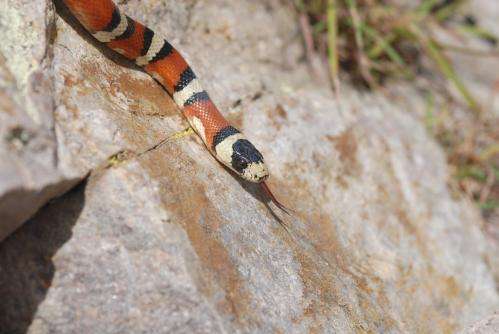Impersonating poisonous prey

Imitation is the most sincere form of flattery – especially in the predator/prey/poison cycle.
In nature, bright colors are basically neon signs that scream, "Don't eat me!" But how did prey evolve these characteristics? When did predators translate the meaning?
In the current issue of the journal PLOS ONE, researchers at Michigan State University reveal that these color-coded communiqués evolve over time through gradual steps. Equally interesting, the scientists show how drab-colored, oft-eaten prey adopt garish colors to live long and prosper, even though they aren't poisonous, said Kenna Lehmann, MSU doctoral student of zoology.
"In some cases, nonpoisonous prey gave up their protection of camouflage and acquired bright colors," said Lehmann, who conducted the research through MSU's BEACON Center for the Study of Evolution in Action. "How did these imitators get past that tricky middle ground, where they can be easily seen, but they don't quite resemble colorful toxic prey? And why take the risk?"
They take the risk because the evolutionary benefit of mimicry works. A nontoxic imposter benefits from giving off a poisonous persona, even when the signals are not even close. Predators, engrained to avoid truly toxic prey, react to the impersonations and avoid eating the imposters.
An example of truly toxic animals and their imitators are coral snakes and king snakes. While coral snakes are poisonous, king snakes are not. Even though king snakes are considered imperfect mimics, they are close enough that predators don't bother them.
Why don't all prey have these characteristics, and why don't the imitators evolve to develop poison instead? Leaving the safety of the cryptic, camouflage peak to go through the exposed adaptive valley over many generations is a dangerous journey, Lehmann said.
"To take the risk of traversing the dangerous middle ground – where they don't look enough like toxic prey – is too great in many cases," she said. "Toxins can be costly to produce. If prey gain protection by colors alone, then it doesn't make evolutionary sense to expend additional energy developing the poison."
The results suggest that these communicative systems can evolve through gradual steps instead of an unlikely large single step. This gives insight into how complex signals, both sent and received, may have evolved through seemingly disadvantageous steps.
Rather than conduct experiments of voracious predators chasing and eating, or completely avoiding, prey, the scientists used evolving populations of digital organisms in a virtual world called Avida.
Avida is a software environment developed at MSU in which specialized computer programs compete and reproduce. Because mutations happen when Avidians copy themselves, which lead to differences in reproductive rates, these digital organisms evolve, just like living things.
Journal information: PLoS ONE
Provided by Michigan State University





















